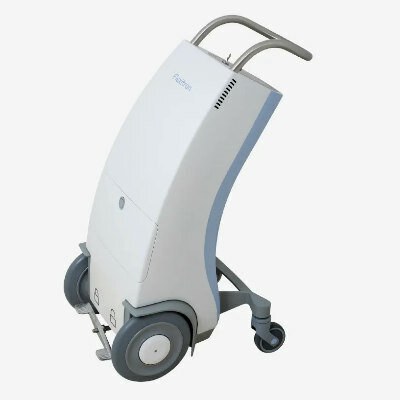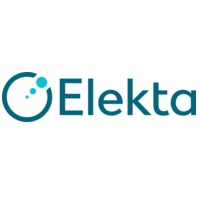Hyperpolarized Xenon MRI Scans Detect Abnormalities in Lungs of Long COVID Patients
|
By MedImaging International staff writers Posted on 07 Feb 2022 |

Using hyperpolarized xenon MRI, researchers have identified abnormalities in the lungs of long COVID patients with breathlessness but whose other tests are normal.
The EXPLAIN study conducted by researchers at the University of Sheffield (Sheffield, UK) and University of Oxford (Oxford, UK) is using hyperpolarized xenon MRI scans to investigate possible lung damage in long COVID patients who experience breathlessness and were not hospitalized when they had COVID-19. These early results suggest that COVID-19 may result in persistent impairment in gas transfer and underlying lung abnormalities. However, the extent to which these abnormalities contribute to breathlessness is currently unclear.
Hyperpolarized xenon MRI requires the patient to lie in an MRI scanner and breathe in one litre of xenon gas that has had its atomic structure altered so it can be seen using MRI. Xenon is an inert gas that behaves in a very similar way to oxygen, so radiologists then can observe how the gas moves from the lungs into the bloodstream. A previous study using the same imaging method established that patients who had been hospitalized with COVID-19 had persistent lung abnormalities several months after they were discharged.
For this pilot study, the researchers recruited 36 patients who fell into three groups: People with long COVID who had normal CT scans; People who had been in hospital with COVID-19 and discharged more than three months previously, who had normal or nearly normal CT scans and who were not experiencing long COVID; and An age- and gender-matched control group who did not have long COVID symptoms nor had been hospitalized with COVID-19. In the initial results, the long COVID patients had abnormal hyperpolarized xenon MRI scans, indicating ‘significantly impaired gas transfer’ from the lungs to the bloodstream. However their CT scans showed normal results.
“We knew from our post-hospital COVID study that xenon could detect abnormalities when the CT scan and other lung function tests are normal,” said the study’s Chief Investigator, Fergus Gleeson, Professor of Radiology at the University of Oxford and Consultant Radiologist at Oxford University Hospitals NHS Foundation Trust. “What we’ve found now is that, even though their CT scans are normal, the xenon MRI scans have detected similar abnormalities in patients with long COVID. These patients have never been in hospital and did not have an acute severe illness when they had their COVID-19 infection. Some of them have been experiencing their symptoms for a year after contracting COVID-19.”
“Xenon MRI is uniquely placed to help understand why breathlessness persists in some patients post COVID,” said Professor Jim Wild and the Pulmonary, Lung and Respiratory Imaging Sheffield (POLARIS) research group at the University of Sheffield, who pioneered hyperpolarized xenon MRI. “Xenon follows the pathway of oxygen when it is taken up by the lungs and can tell us where the abnormality lies between the airways, gas exchange membranes and capillaries in the lungs.”
“These are interesting results and may indicate that the changes observed within the lungs of some patients with long COVID contribute to breathlessness. However, these are early findings and further work to understand the clinical significance is key,” said co-researcher Dr Emily Fraser, a Respiratory Consultant who leads the Oxford Post-COVID Assessment Clinic. “Extending this study to larger numbers of patients and looking at control groups who have recovered from COVID should help us to answer this question and further our understanding of the mechanisms that drive long COVID.”
Related Links:
University of Sheffield
University of Oxford
Latest MRI News
- PET/MRI Improves Diagnostic Accuracy for Prostate Cancer Patients
- Next Generation MR-Guided Focused Ultrasound Ushers In Future of Incisionless Neurosurgery
- Two-Part MRI Scan Detects Prostate Cancer More Quickly without Compromising Diagnostic Quality
- World’s Most Powerful MRI Machine Images Living Brain with Unrivaled Clarity
- New Whole-Body Imaging Technology Makes It Possible to View Inflammation on MRI Scan
- Combining Prostate MRI with Blood Test Can Avoid Unnecessary Prostate Biopsies
- New Treatment Combines MRI and Ultrasound to Control Prostate Cancer without Serious Side Effects
- MRI Improves Diagnosis and Treatment of Prostate Cancer
- Combined PET-MRI Scan Improves Treatment for Early Breast Cancer Patients
- 4D MRI Could Improve Clinical Assessment of Heart Blood Flow Abnormalities
- MRI-Guided Focused Ultrasound Therapy Shows Promise in Treating Prostate Cancer
- AI-Based MRI Tool Outperforms Current Brain Tumor Diagnosis Methods
- DW-MRI Lights up Small Ovarian Lesions like Light Bulbs
- Abbreviated Breast MRI Effective for High-Risk Screening without Compromising Diagnostic Accuracy
- New MRI Method Detects Alzheimer’s Earlier in People without Clinical Signs
- MRI Monitoring Reduces Mortality in Women at High Risk of BRCA1 Breast Cancer
Channels
Radiography
view channel
Novel Breast Imaging System Proves As Effective As Mammography
Breast cancer remains the most frequently diagnosed cancer among women. It is projected that one in eight women will be diagnosed with breast cancer during her lifetime, and one in 42 women who turn 50... Read more
AI Assistance Improves Breast-Cancer Screening by Reducing False Positives
Radiologists typically detect one case of cancer for every 200 mammograms reviewed. However, these evaluations often result in false positives, leading to unnecessary patient recalls for additional testing,... Read moreMRI
view channel
PET/MRI Improves Diagnostic Accuracy for Prostate Cancer Patients
The Prostate Imaging Reporting and Data System (PI-RADS) is a five-point scale to assess potential prostate cancer in MR images. PI-RADS category 3 which offers an unclear suggestion of clinically significant... Read more
Next Generation MR-Guided Focused Ultrasound Ushers In Future of Incisionless Neurosurgery
Essential tremor, often called familial, idiopathic, or benign tremor, leads to uncontrollable shaking that significantly affects a person’s life. When traditional medications do not alleviate symptoms,... Read more
Two-Part MRI Scan Detects Prostate Cancer More Quickly without Compromising Diagnostic Quality
Prostate cancer ranks as the most prevalent cancer among men. Over the last decade, the introduction of MRI scans has significantly transformed the diagnosis process, marking the most substantial advancement... Read moreUltrasound
view channel
Deep Learning Advances Super-Resolution Ultrasound Imaging
Ultrasound localization microscopy (ULM) is an advanced imaging technique that offers high-resolution visualization of microvascular structures. It employs microbubbles, FDA-approved contrast agents, injected... Read more
Novel Ultrasound-Launched Targeted Nanoparticle Eliminates Biofilm and Bacterial Infection
Biofilms, formed by bacteria aggregating into dense communities for protection against harsh environmental conditions, are a significant contributor to various infectious diseases. Biofilms frequently... Read moreNuclear Medicine
view channel
New SPECT/CT Technique Could Change Imaging Practices and Increase Patient Access
The development of lead-212 (212Pb)-PSMA–based targeted alpha therapy (TAT) is garnering significant interest in treating patients with metastatic castration-resistant prostate cancer. The imaging of 212Pb,... Read moreNew Radiotheranostic System Detects and Treats Ovarian Cancer Noninvasively
Ovarian cancer is the most lethal gynecological cancer, with less than a 30% five-year survival rate for those diagnosed in late stages. Despite surgery and platinum-based chemotherapy being the standard... Read more
AI System Automatically and Reliably Detects Cardiac Amyloidosis Using Scintigraphy Imaging
Cardiac amyloidosis, a condition characterized by the buildup of abnormal protein deposits (amyloids) in the heart muscle, severely affects heart function and can lead to heart failure or death without... Read moreGeneral/Advanced Imaging
view channel
New AI Method Captures Uncertainty in Medical Images
In the field of biomedicine, segmentation is the process of annotating pixels from an important structure in medical images, such as organs or cells. Artificial Intelligence (AI) models are utilized to... Read more.jpg)
CT Coronary Angiography Reduces Need for Invasive Tests to Diagnose Coronary Artery Disease
Coronary artery disease (CAD), one of the leading causes of death worldwide, involves the narrowing of coronary arteries due to atherosclerosis, resulting in insufficient blood flow to the heart muscle.... Read more
Novel Blood Test Could Reduce Need for PET Imaging of Patients with Alzheimer’s
Alzheimer's disease (AD), a condition marked by cognitive decline and the presence of beta-amyloid (Aβ) plaques and neurofibrillary tangles in the brain, poses diagnostic challenges. Amyloid positron emission... Read more.jpg)
CT-Based Deep Learning Algorithm Accurately Differentiates Benign From Malignant Vertebral Fractures
The rise in the aging population is expected to result in a corresponding increase in the prevalence of vertebral fractures which can cause back pain or neurologic compromise, leading to impaired function... Read moreImaging IT
view channel
New Google Cloud Medical Imaging Suite Makes Imaging Healthcare Data More Accessible
Medical imaging is a critical tool used to diagnose patients, and there are billions of medical images scanned globally each year. Imaging data accounts for about 90% of all healthcare data1 and, until... Read more
Global AI in Medical Diagnostics Market to Be Driven by Demand for Image Recognition in Radiology
The global artificial intelligence (AI) in medical diagnostics market is expanding with early disease detection being one of its key applications and image recognition becoming a compelling consumer proposition... Read moreIndustry News
view channel
Bayer and Google Partner on New AI Product for Radiologists
Medical imaging data comprises around 90% of all healthcare data, and it is a highly complex and rich clinical data modality and serves as a vital tool for diagnosing patients. Each year, billions of medical... Read more





















